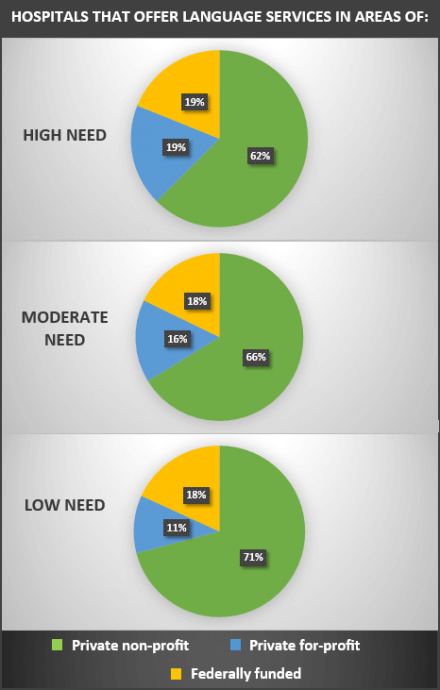The American Community Survey (ACS) is a yearly study of U.S. citizens performed by the U.S. Census Bureau that provides a much more granular view of the U.S population than the full census that takes place once a decade. According to the latest available ACS data, surveyed in 2016, 21.6% of the people living in the United States speak a language other than English at home. Of these, nearly 40% speak English “less than well.”
For whatever difficulties this may cause in their daily lives, when these people seek medical care, the language barrier can become downright dangerous or even deadly. Protecting their safety is viewed as a critical civil rights issue addressed in Section 1557 of the Patient Protection and Affordable Care Act (ACA). Federally funded hospitals are, in fact, required to “take reasonable steps to provide meaningful medical access to each individual with limited English proficiency (LEP) who is eligible to be served or likely to be encountered within the entities’ health programs and activities.”
Why is language support necessary?
Robust interpretation and translation services allow patients to communicate fully with healthcare providers before, during and after treatment. This is far more than a mere convenience to them – language misunderstandings can have tragic results in a medical context. The Huffington Post shared a few such horror stories:
- A 9-year-old girl died as a result of her doctor failing to explain her medication’s dangerous side-effects to her Vietnamese-speaking parents.
- Because doctors didn’t understand a Russian-speaking 78-year-old stroke victim’s complaints of pain and numbness, her leg had to eventually be amputated.
- A 7-year-old boy suffered organ damage when his doctor couldn’t communicate well enough with his Spanish-speaking father and grandparents over the course of several appointments.
The current landscape for people with LEP
At first glance, the statistics seem to show a trend of compliance with Section 1557’s language assistance requirements. According to a study published in Health Affairs, in which over 4,500 U.S. hospitals were surveyed, the majority are offering non-English support:
- 65% of hospitals located in areas of low need for language services provided them.
- 77% of hospitals located in areas of moderate need for language services provided them.
- 75% of hospitals located in areas of high need for language services provided them. These facilities are primarily in the West and Southwest of the country.
However, a closer look at the research shows something much more alarming: Federally funded hospitals account for less than 20% of this data – regardless of where they are located.
Three types of hospitals
The data above measures medical translation and interpretation services offered by three types of hospitals: federally funded hospitals, private non-profit hospitals, and private for-profit hospitals. The federally funded hospitals are the only ones required by law to provide language services for those with limited English proficiency. Yet, it’s the private non-profit hospitals that are actually providing most of the language services measured across the country.

As you can see, 81% of federally funded hospitals in the areas of highest need do not offer language services. This is in direct violation of Section 1557’s requirement to “take reasonable steps to provide meaningful medical access to people with limited English proficiency.” And while the danger of this status quo is known, the future of Section 1557 is not.
Looking forward
As part of the politically charged ACA, the future of Section 1557 is unclear. While politicians have signaled opposition to its gender-related protections, nothing has been said about Section 1557’s support for people with limited English proficiency. However, its benefits are clear:
- Human rights – Providing language services helps hospitals to meet the basic human right for meaningful access to medical care.
- Saving money – Medical facilities are coming to understand that reducing language-related errors can actually save them money in the long-term. Carey Sanders of the California Pan-Ethnic Health Network tells Huffington Post, “The language services are going to keep people healthier and that will end up saving health care dollars down the road. It’s a small investment for a big return.”
- Patient satisfaction – Research has clearly demonstrated that providing language services increases a hospital’s patient satisfaction percentages. Under the ACA, these can lead to improved patient-experience reports in HCAHPS surveys, resulting in increased ACA incentive payments.
Making a plan
Devising a solution requires a hospital to undertake a thoughtful examination of the local populations it serves. According to the ACS, Spanish is the most widely spoken Non-English language in U.S. homes, but it is likely that services may also be needed for other languages, including other Indo-European, Asian and Pacific tongues.
Finding expert medical interpreters can, of course, be a daunting challenge. Fortunately, a full-service LSP such as Morningside can provide the requisite range of qualified interpreters and translators to help ensure a hospital’s delivery of effective and safe health care to its entire community.


